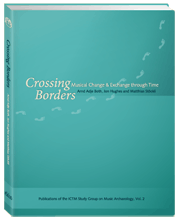A Study of the Music and Dance Images in the Hinayana Buddhist Mural Paintings of the Dai People in Yunnan, China
Wang Ling
Most music and dance scenes depicted in the mural paintings in the Dai people’s Hinayana
Buddhist temples in Yunnan, China, are related to Buddhist scriptural stories or Dai folk activities. Scenes in the mural ‘Da Biqiu Yuanji’ suggest that during the Qing Dynasty the Dai
people used to make music and dance at funerals. Dai dances accompanied by the guangkela
can be classified according to three drum sizes. Judging from their costumes, postures, and
accompanying instruments, we may suggest that the three Dai girls in the mural ‘Jingfo Tu’
are shown performing a dance of Burmese origin as part of Buddhist ritual practices, and
bear witness to the continuous northward spread of Hinayana Buddhism and Burmese culture.
Considering their similarities in form, images of the peacock dance in the murals ‘Kongque Wu’
and ‘Zhao Shutun yu Nanmu Nuona’ are realistic representations of specific Dai folk dances.
The peacock dance fuses elements of local Dai culture, Han culture from the central plains of
China, and Buddhist culture from South and Southeast Asia. The formation of Dai dances
can in part be attributed to specific religious factors, as well as to cultural exchange between
the Dai and the Burmese people, and between the Dai and the Han people of the central plains
of China. Cultural exchange between the ethnic groups of Yunnan and those of neighbouring
Myanmar has been constant throughout history. It was probably because of their common
belief in Hinayana Buddhism that Burmese culture exerted influence on the music and dance
traditions of the Dai people in Yunnan. Such cultural exchange and fusion may have further
promoted friendly relations between Yunnan, China, and neighbouring South and Southeast
Asian countries.




